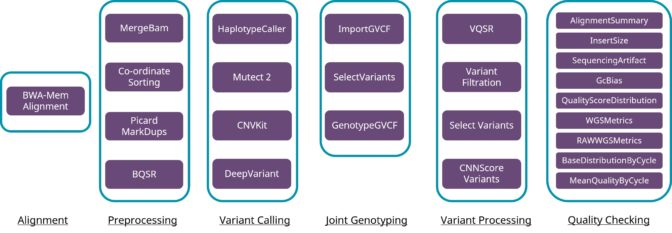AI, Accelerated Computing Drive Shift to Personalized Healthcare
NVIDIA Doubles down on GPU-Accelerated Genomics, Enables Firsts in AI for Medical Imaging.
Genomics is finally poised to go mainstream, with help from deep learning and accelerated-computing technologies from NVIDIA.
Since the first human genome was sequenced in 2003, the cost of whole genome sequencing has steadily shrunk, far faster than suggested by Moore’s law. From sequencing the genomes of newborn babies to conducting national population genomics programs, the field is gaining momentum and getting more personal by the day.
Advances in sequencing technology have led to an explosion of genomic data. The total amount of sequence data is doubling every seven months. This breakneck pace could see genomics in 2025 surpass by 10x the amount of data generated by other big data sources such as astronomy, Twitter and YouTube hitting the double-digit exabyte range.
New sequencing systems, like the DNBSEQ-T7 from BGI Group, the world’s largest genomics research group, are pushing the technology into broad use. The system generates a whopping 60 genomes per day, equaling 6 terabytes of data.
With advancements in BGI’s flow cell technology and acceleration by a pair of NVIDIA V100 Tensor Core GPUs, DNBSEQ-T7 sequencing is sped up 50x, making it the highest throughput genome sequencer to date.
As costs decline and sequencing times accelerate, more use cases emerge, such as the ability to sequence a newborn in intensive care where every minute counts.
Getting Past the Genome Analysis Bottleneck: GPU-Accelerated GATK
The genomics community continues to extract new insights from DNA. Recent breakthroughs include single-cell sequencing to understand mutations at a cellular level, and liquid biopsies that detect and monitor cancer using blood for circulating DNA.
But genomic analysis has traditionally been a computational bottleneck in the sequencing pipeline one that can be surmounted using GPU acceleration.
To deliver a roadmap of continuing GPU acceleration for key genomic analysis pipelines, the team at Parabricks — an Ann Arbor, Michigan-based developer of GPU software for genomics — is joining NVIDIA’s healthcare team, NVIDIA founder and CEO Jensen Huang shared today onstage at GTC China.
Teaming up with BGI, the Parabricks’ software can analyze a genome in under an hour. Using a server with eight NVIDIA T4 Tensor Core GPUs, BGI showed the throughput could lower the cost of genome sequencing to $2 less than half the cost of existing systems.
See More, Do More with Smart Medical Devices
New medical devices are being invented across the healthcare industry. United Imaging Healthcare has introduced two industry-first medical devices. The uEXPLORER is the world’s first total body PET-CT scanner. Its pioneering ability to image an individual in one position enables it to carry out fast, continuous tracking of tracer distribution over the entire body.

The total-body coverage of uEXPLORER can significantly shorten scan time. Scans as brief as 30 seconds provide good image quality, compared to traditional systems requiring over 20 minutes of scan time. uEXPLORER is also setting a new benchmark in tracer dose imaging at about 1/50 of the regular dose, without compromising image quality.
The FDA-approved system uses 16 NVIDIA V100 Tensor Core GPUs and eight 56 GB/s InfiniBand network links from Mellanox to process movie-like scans that can acquire up to a terabyte of data. The system is already deployed in the U.S. at the University of California, Davis, where scientists helped design the system. It’s also the subject of an article in Nature, as well as videos watched by nearly half a million viewers on YouTube.
United’s other groundbreaking system, the uRT-Linac, is the first instrument to support a full radiation therapy suite, from detection to prevention.
With this instrument, a patient from a remote village can make the long trek to the nearest clinic just once to get diagnostic tests and treatment. The uRT-Linac combines CT imaging, AI processing to assist in treatment planning, and simulation with the radiation therapy delivery system. Using multi-modal technologies and AI, United has changed the nature of delivering cancer treatment.
Further afield, a growing number of smart medical devices are using AI for enhanced signal and image processing, workflow optimizations and data analysis.
And on the horizon are patient monitors that can sense when a patient is in danger and smart endoscopes that can guide surgeons during surgery. It’s no exaggeration to state that, in the future, every sensor in the hospital will have AI-infused capabilities.
Our recently announced NVIDIA Clara AGX developer kit helps address this trend. Clara AGX comprises hardware based on NVIDIA Xavier SoCs and Volta Tensor Core GPUs, along with a Clara AGX software development kit, to enable the proliferation of smart medical devices that make healthcare both smarter and more personal.
Read More: FiO Fixes Wine, Gaming and Fitness Industry Pain Points


Copper scrap testing Copper scrap recycling process Metal reclamation depot
Copper cable scrap environmental impact, Metal reclaiming and recovery, Copper scrap resource conservation
Metal reuse Ferrous material client retention Iron scrap sales
Ferrous scrap import, Iron reclamation and recovery solutions, Metal waste resale
I have seen a video about this on youtube. I don’t know if it is the video you mentioned in the article. But I was really impressed with your article. geometry dash